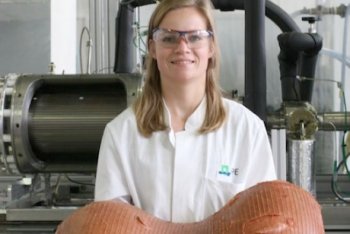
Professor Atze Jan van der Goot and his group from Wageningen University developed a new technology that fabricates the ingredients from legumes, such as soy beans, in such a way that a ‘meat structure’ develops with the fineness and fibre structure from a steak. This concept is the basis for the development of a vegetarian steak. The product makes animal ingredients, such as egg or whey, unnecessary and does not have any limitations size-wise.
Meat structure
The researchers from Wageningen, together with colleagues from TU Delft, have built a working prototype for the production of vegetable-based pieces of ‘meat’. With the device, one can mimic meat-like structures from soy proteins, in a piece of a few kilograms (60x30x3 cm); which is too large to fit on two plates. The structure is finer as so far reached by the currently available method (extrusion). Besides, the method is much more energy efficient compared to existing production methods of meat replacers.
Shear Cell Technology
With so-called 'Shear Cell Technology', the group said it is possible to deform vegetable proteins that result in the desirable fibre structure, providing a new phase in the development of meat alternatives. Initially, this method has been used to make fibres out of dairy proteins, but to be genuinely sustainable, Van der Groot said one should focus on vegetable proteins. “One needs to take into account the whole production process and criticize all ingredients based on their sustainability. Then, it turns out that way less energy gets lost when producing with vegetable proteins.”
Meat structure
He added that the processing and structuring of vegetable proteins is more complex than dairy proteins. Nevertheless, Van der Goot’s research team was able to make meat replacements from vegetable proteins that are larger as stir-fry cubes. Van der Goot, said, “Now, we understand via which mechanisms vegetable proteins form structures. Due to this scientific insight we can develop a pure, vegetable-based, wholesome meat replacers, which the structure from meat.”
The food technologist said he is unable to tell how much time it takes before the new, sustainable meat replacement reaches the market. “First, our prototype needs to be developed further up to a full production facility.”
Public-private collaboration
The research was supported by the ISPT (Institute for Sustainable Process Technology) and a facilitated public-private collaboration between Wageningen UR, TU Delft, the Vegetarian Butcher and The Peas Foundation.



 Classifieds
Classifieds

